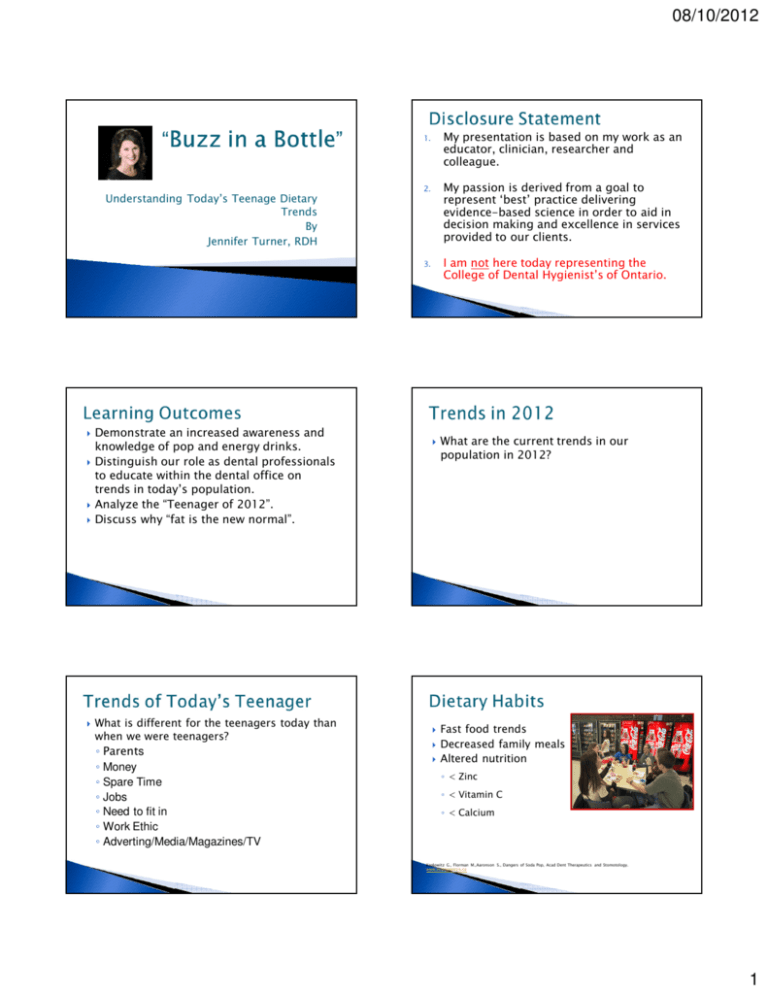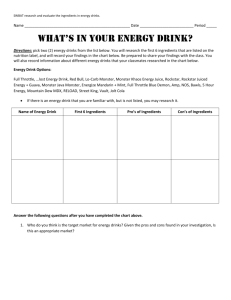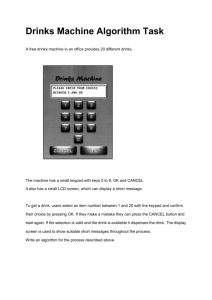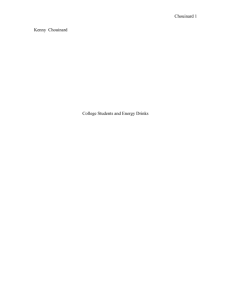My presentation is based on my work as an educator, clinician
advertisement

08/10/2012 1. My presentation is based on my work as an educator, clinician, researcher and colleague. 2. My passion is derived from a goal to represent ‘best’ practice delivering evidence-based science in order to aid in decision making and excellence in services provided to our clients. 3. I am not here today representing the College of Dental Hygienist’s of Ontario. Understanding Today’s Teenage Dietary Trends By Jennifer Turner, RDH Demonstrate an increased awareness and knowledge of pop and energy drinks. Distinguish our role as dental professionals to educate within the dental office on trends in today’s population. Analyze the “Teenager of 2012”. Discuss why “fat is the new normal”. What is different for the teenagers today than when we were teenagers? ◦ Parents ◦ Money ◦ Spare Time ◦ Jobs ◦ Need to fit in ◦ Work Ethic ◦ Adverting/Media/Magazines/TV What are the current trends in our population in 2012? Fast food trends Decreased family meals Altered nutrition ◦ < Zinc ◦ < Vitamin C ◦ < Calcium Kaplowitz G., Florman M.,Aaronson S., Dangers of Soda Pop, Acad Dent Therapeutics and Stomotology. www.osteoporosis.ca 1 08/10/2012 Why is fat the new normal? Statistics Canada reported that 3 out of 10 children/adolescents are overweight or obese. Teenagers are at risk for: ◦ ◦ ◦ ◦ Do You Know How Food Portions Have Changed in 20 Years? High Blood Pressure Type 2 Diabetes Heart Disease Stroke What kinds of conversations are you having with your patients regarding pop consumption? Are there any Treatment Plan modifications for a patient who has a high sugar intake with pop? Does it matter that it is in the form of liquid consumption? 2. Weight Gain Studies have tied diet pop to weight gain to an increased risk of obesity. How could a zero calorie drink put you at risk of obesity? Many people think because of the zero calories in the diet pop they can eat more food. National Heart, Lung, and Blood Institute Obesity Education Initiative 1. Kidney Damage Those that drink at least 2 cans or more of diet pop have 30% less reduction of kidney function. The thought is that the sweeteners used in diet pop may scar the kidney tissue over time. Evidence is still being researched to prove kidney damage in diet pop. 3. Tooth Enamel Damage Pop is hard on tooth enamel. Diet pop eliminates the sugar but the not the acid content of pop. Phosphoric and Citric Acid are in many pops. If you can’t kick the habit of diet pop try drinking it through a straw. 2 08/10/2012 4. Bone Loss The phosphoric acid in the pop causes calcium in your bloodstream to be excreted more quickly through urine. Your bones then give up some of their calcium in order to keep the bloodstream calcium level constant. What is an energy drink? What is a sports drink? Are they healthy? - - What about H20? - Red Bull was the first company to start the energy drink craze in the US. It still remains the best selling energy drink today. Red Bull is the litmus test against which all other energy beverages are judged against. Energy drinks were introduced in the US market in 1997. Fastest growing market in the US for beverage sales. Over 500 new kinds of energy drinks marketed last year. People actually think that energy drinks are good for them and that it is healthy. Monster is a favorite with consumers for selling a beverage twice the size of a Red Bull for the same price. Monster drinks have way more sugar, taurine and caffeine than Red Bull, unless you get the Monster Lo Carb, which is a less powerful beverage. 3 08/10/2012 The 5-hour Energy Drink has recently risen to become another industry favorite. . It is packed with 2000 percent of the daily value of vitamin B6, 8,333 percent of the daily value of vitamin B12, and 100 mg of caffeine. - - - Monster $2.79, Size 18.6 oz, Servings 2.3 Calories 90, Carbs 22, Sodium 200mg 5 Hour Energy Orange $2.49, Size 2 oz, Calories 4, Carbs 0, Sodium 10 mg Red Bull $2.89, Size 8.3 oz, Servings 1, Calories 110, Carbs 28 g, Sodium 200 mg Is known to increase energy, has some antifatigue components, supposedly relieves stress, and increase memory. Ginseng is nothing that’s naturally created by your body, so having this in your drink certainly won’t hurt. 200mg/day seems to be the standard dose, but you can safely take up to 2700mg. Rare side effects such as diarrhea and headache have been reported. Teenagers can become intoxicated by the caffeine in the energy drinks after consuming 2-5 drinks per day. Energy drinks are understudied, overused and can be dangerous for teenagers. The media has teenagers wanting to drink energy drinks because they look cool. Taurine is an amino acid that your body naturally produces. It helps regulate heartbeat, muscle contractions, and energy levels. Usually your body makes enough that you don’t need to supplement. It’s thought, but not proven, that under “stress conditions” like illness, physical exertion, or injury, the body does not create enough and supplements can help. Taurine in the past was banned by some countries from being used as a supplement. 4 08/10/2012 Guarana comes from plants native to South America. Amazonians have used it for a long time to increase alertness and energy. It’s more dense in caffeine than coffee beans (3-4% vs 1-2%). It’s not just called “caffeine” because it contains a couple other things: theobromine and theophylline. They’re found in coffees and teas and are known stimulants. This is the primary boost ingredient and potentially the most dangerous. Caffeine interferes with intestinal calcium absorption, energy drinks may cause problems for strong bone development if this is a primary drink for the teenager. Large amounts of sugar in the energy drinks can cause dental decay and lead to weight gain. With weight gain comes an increased risk of weight related conditions, such as HBP and Type 2 diabetes. Glucose is the body’s preferred fuel. That is why you get hyper with a lot of sugar. Some people do respond differently to the version of caffeine in guarana compared with regular caffeine. Some people report that guarana works better, while others believe it doesn’t have as good of stimulating effect. Make a withdrawal schedule instead of abruptly stopping the energy drinks. Withdraw over a 3 to 5 day period by cutting the caffeine from a quarter to a half, until you are at no energy drinks. The teenager will be irritable, crank, headaches, nausea and have insufficient sleep during this period. However, too much sugar intake has been linked to diabetes and can spike insulin levels which can often lead to a “crash” feeling after about an hour or so. One Rockstar energy drink can have 63 grams of sugar which is the same amount in two regular size Snickers candy bars! Which snack would you rather pick? 5 08/10/2012 Teenagers who consume energy drinks are calling them the new high that is equivalent to marijuana. Teens assume that the caffeine in these drinks will allow them to get by on only 6 to 7 hours of sleep instead of the 9 hours they should be getting. How do we feel with 3 to 4 hours less sleep per night? Stomach upset Irritability Sleep disruption Blood pressure changes Heart arrhythmias Behavioural pattern changes The risk of cardiovascular complications increase when energy drinks are combined with other drugs or stimulants. Teenagers believe that they will get a quick lift and get more energy to give them improved performance and concentration. Teenagers can stay up all night, studying, dancing or partying. Drink of choice for a “Rave” is Monster or Red Bull. What kind of toothpaste are we recommending to our patients and why? Do you know how abrasive the toothpaste you are using is? How can we advise people to switch toothpastes? Age of first alcohol use. Age of first drug use. Age of first sexual experience. 6 08/10/2012 63% binge drinking teens become pregnant! Unwanted & unprotected sex Increased risk STI 40% of traffic fatalities amongst 16 – 19 y.o. involved alcohol Many people state “if I have a drink then I have the urge to smoke, it just goes hand in hand”. How do we help teenagers from starting to smoke? Motivation No system Not enough time Inadequate technique Interdental cleaning Conversations with teenagers and parents. Visual posters in your operatory. Office newsletters. Pamphlets in the waiting room. Follow up on oral hygiene education from previous appointment. Encouraging regular recall/re-care appointments. jturner@therdhnetwork.com www.therdhnetwork.com 7



